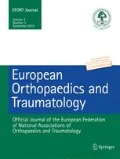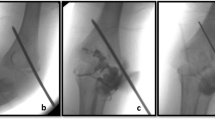Abstract
Background
This fracture is rare and is often missed in emergency if good lateral radiographs are not available. This paper presents the diagnosis and management of type 4 capitellar fractures (Mckee) with 4-mm cancellous screws after subclassification of fracture and different surgical modalities for each subtype
Material and methods
Five cases were treated from 2012 to 2014 for type IV capitellar fracture of the right side. There were three males and two females, all adult with an average age of 31 years. Double arc sign was seen in lateral view in three patients. No patient underwent CT scan. Under tourniquet, using extended lateral approach, open reduction and internal fixation was done using 4-mm partially threaded cannulated cancellous screws under vision from posterior to anterior direction from the posterior aspect of lateral condyle of the humerus avoiding articular penetration (except one screw). If the fracture was found to involve medial flange of the trochlea, then one cancellous screw was passed through posteromedial incision (type B).
Results
All the fractures united uneventfully. At the end of 1 year follow-up, all had excellent elbow function with no signs of AVN or arthritis.
Conclusion
Double arc sign on lateral X-rays of the elbow is important for diagnosis and analysis of type IV capitellar fracture. Fixation with cannulated ordinary screws using extended Kocher’s lateral approach has given good results. Subclassification with medial screw for type B helped to anatomically reduce and stabilize type B fracture. Thus, the subclassification has a therapeutic value.










Similar content being viewed by others
References
Poynton AR, Kelly IP, O'Rourke SK (1998) Fractures of the capitellum: a comparison of two fixation methods. Injury 29:341–343
Alvarez E, Patel MR, Nimberg G, Pearlman HS (1975) Fractures of the capitellum humeri. J Bone Joint Surg Am 57:1093–1096
De Boeck H, Pouliart N (2000) Fractures of the capitellum humeri in adolescents. Int Orthop 24:246–248
Pradhan BB, Bhasin D, Krom W (2005) Capitellar fracture in a child: the value of an oblique radiograph: a case report. J Bone Joint Surg Am 87:635–638
Ochner RS, Bloom H, Palumbo RC, Coyle MP (1996) Closed reduction of coronal fractures of the capitellum. J Trauma 40:199–203
Mazel MS (1935) Fracture of the capitellum: a report of a case. J Bone Joint Surg Am 17:483–488
Fowles JV, Kassab MT (1974) Fracture of the capitellum humeri: treatment by excision. J Bone Joint Surg Am 56:794–798
Lambert SM, Pike J, Railton GT (1994) Fractures of the humeral capitellum: Herbert screw fixation. J R Coll Surg Edinb 39:321–323
Sano S, Rokkaku T, Saito S, Tokunaga S, Abe Y, Moriya H (2005) Herbert screw fixation of capitellar fractures. J Shoulder Elb Surg 14:307–311
McKee MD, Jupiter JB, Bamberger HB (1996) Coronal shear fractures of the distal end of the humerus. J Bone Joint Surg Am 78:49–54
Schindler OS (2003) Bilateral capitellum humeri fracture: a case report and review of the literature. J Orthop Surg (Hong Kong) 24(11):207–212
Letts M, Rumball K, Bauermeister S, McIntyre W, D'Astous J (1997) Fractures of the capitellum in adolescents. J Pediatr Orthop 17:315–320
Grantham SA, Norris TR, Bush DC (1981) Isolated fracture of the humeral capitellum. Clin Orthop Relat Res 161:262–269
Morrey BF, An KN, Stormont TJ (1988) Force transmission through the radial head. J Bone Joint Surg Am 70:250–256
Greenspan A, Norman A, Rosen H (1984) Radial head-capitellum view in elbow trauma: clinical application and radiographic-anatomic correlation. AJR Am J Roentgenol 143:355–359
Pogliacomi F, Concari G, Vaienti E (2005) Hahn-Steinthal fracture: report of two cases. Acta Biomed 76:178–184
Elkowitz SJ, Polatsch DB, Egol KA, Kummer FJ, Koval KJ (2002) Capitellum fractures: a biomechanical evaluation of three fixation methods. J Orthop Trauma 16:503–506
Mighell MA, Harkins D, Klein D, Schneider S, Frankle M (2006) Technique for internal fixation of capitellum and lateral trochlea fractures. J Orthop Trauma 20:699–704
Bilić R, Kolundzić R, Anticević D (2006) Absorbable implants in surgical correction of a capitellar malunion in an 11-year old: a case report. J Orthop Trauma 20:66–69
Christopher F (1935) Conservative treatment of fracture of the capitellum. J Bone Joint Surg Am 17:489–492
Dushuttle RP, Coyle MP, Zawadsky JP, Bloom H (1985) Fractures of the capitellum. J Trauma 25:317–321
Mehdian H, McKee MD (2000) Fractures of the capitellum and trochlea. Orthop Clin North Am 31:115–127
Acknowledgments
The authors thank Dr Sunil V. Patil, Professor and HOD, Department of Orthopaedics, Bharati Vidyapeeth Deemed University and Medical College, Sangli, for his inspiring support and guidance.
Compliance with Ethical Standards
ᅟ
Conflict of interest
The authors declare that they have no competing interests.
Ethical approval
All procedures performed in studies involving human participants were in accordance with the ethical standards of the institutional and/or national research committee and with the 1964 Helsinki declaration and its later amendments or comparable ethical standards. A written, valid and informed consent has been taken from all the human subjects involved in the study. This article does not contain any studies with animals performed by any of the authors.
Funding
Nil.
Author information
Authors and Affiliations
Corresponding author
Rights and permissions
About this article
Cite this article
Naik, N.P., Parakh, S.J. & Deshpande, S.B. Therapeutic subclassification of type IV capitellum fracture: a new approach. Eur Orthop Traumatol 6, 373–379 (2015). https://doi.org/10.1007/s12570-015-0319-x
Received:
Accepted:
Published:
Issue Date:
DOI: https://doi.org/10.1007/s12570-015-0319-x




